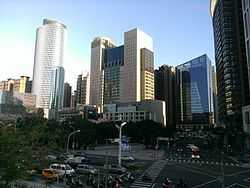Special municipality (Taiwan)
| This article is part of Administrative divisionsa series on the of the Republic of China (Taiwan) | ||||||||||||
| In effect | ||||||||||||
|---|---|---|---|---|---|---|---|---|---|---|---|---|
| 1st | Provinces (省 shěng) (streamlined) | |||||||||||
| Special municipalities (直轄市 zhíxiáshì) | ||||||||||||
| 2nd | Counties (縣 xiàn) | |||||||||||
| Provincial cities (市 shì) | ||||||||||||
| 3rd | Districts (區 qū) | |||||||||||
| County-controlled cities (縣轄市 xiànxiáshì) | ||||||||||||
| Urban townships (鎮 zhèn) | ||||||||||||
| Rural townships (鄉 xiāng) | ||||||||||||
| 4th | Urban villages (里 lǐ) | |||||||||||
| Rural villages (村 cūn) | ||||||||||||
| 5th | Neighborhoods (鄰 lín) | |||||||||||
|
Suspended
| ||||||||||||
Special municipalities (Chinese: 直轄市; pinyin: zhíxiáshì; Pe̍h-ōe-jī: Ti̍t-hat-chhī) are one of first-level divisions in Taiwan. Currently there are five special municipalities in Taiwan: Kaohsiung, New Taipei, Taichung, Tainan, and Taipei. In addition, Taoyuan is planning to be approved as the sixth special municipality in 2014. [1]
Position in hierarchy
Special municipalities are the highest level cities in Taiwan. Some cities of lower levels may also refer to themselves as municipalities.[2] However, refers to them using the following conventional terms:
Three levels of cities in Taiwan:
- Special municipalities (直轄市 zhíxiáshì)
- Provincial cities (市 shì or 省轄市 shěngxiáshì)
- County-controlled cities (縣轄市 xiànxiáshì)
History
Mainland Era
In the era, the Republic of China government ruled mainland China, twelve cities were ever assigned as special municipalities. They are
| No | Name | Current place | No | Name | Current place | No | Name | Current place | |||||
|---|---|---|---|---|---|---|---|---|---|---|---|---|---|
| 51 | Nanking | 南京 | Nanjing, Jiangsu | 55 | Tientsin | 天津 | Municipality of Tianjin | 59 | Hankou | 漢口 | Wuhan, Hubei | ||
| 52 | Shanghai | 上海 | Municipality of Shanghai | 56 | Chungking | 重慶 | Municipality of Chongqing | 60 | Canton | 廣州 | Guangzhou, Guangdong | ||
| 53 | Peiping | 北平 | Municipality of Beijing | 57 | Dairen | 大連 | Dalian, Liaoning | 61 | Sian | 西安 | Xi'an, Shaanxi | ||
| 54 | Tsingtao | 青島 | Qingdao, Shandong | 58 | Harbin | 哈爾濱 | Harbin, Heilongjiang | 62 | Mukden | 瀋陽 | Shenyang, Liaoning | ||
The system of top-level municipality were designed in 1927 soon after they were designated as "cities" during the 1920s. These cities were first called special municipalities/cities (Chinese: 特別市; pinyin: tébíeshì), but were later renamed Yuan-controlled municipalities (Chinese: 院轄市; pinyin: yùanxíashì), by the Central Government.
Taiwan Era
Five special municipalities in Taiwan were created after the Republic of China government took control following World War II. Taipei was made a Yuan-controlled municipality in 1967; Kaohsiung was elevated in 1979; New Taipei, Taichung and Tainan also elevated to special municipality in 2010. Since 1994, Yuan-controlled municipalities (院轄市 yuànxiáshì) have been officially called special municipality (直轄市 zhíxiáshì) to emphasize their autonomy. Besides significant political, economic and cultural development, the ROC law dictates that a municipality must have population of over 1,250,000.
Administration
In Taiwanese municipalities, the mayor is the highest-ranking official in charge. The mayor is directly elected by the people registered in the municipality for a duration of four years.
Current special municipalities
| No. | Name | Chinese | Mandarin Pinyin | Taiwanese Pe̍h-oē-jī | Hakka Pha̍k-fa-sṳ |
Population | Area (km²) | Date of establishment | Mayor | Map |
|---|---|---|---|---|---|---|---|---|---|---|
| 1 | Kaohsiung City | 高雄市 | Gāoxióng shì | Ko-hiông-chhī | Kô-hiùng-sṳ | 2,769,083 | 2,946.2527 | Jul. 1, 1979 | Chen Chu | .svg.png)
1 2 3 4 5 |
| 2 | New Taipei City | 新北市 | Xīnběi shì | Sin-pak-chhī | Sîn-pet-sṳ | 3,849,492 | 2,052.5667 | Dec. 25, 2010 | Eric Chu | |
| 3 | Taichung City | 臺中市 台中市 |
Táizhōng shì | Tâi-tiong-chhī | Thòi-chûng-sṳ | 2,629,323 | 2,214.8968 | Dec. 25, 2010 | Jason Hu | |
| 4 | Tainan City | 臺南市 台南市 |
Táinán shì | Tâi-lâm-chhī | Thòi-nàm-sṳ | 1,873,681 | 2,191.6531 | Dec. 25, 2010 | William Lai | |
| 5 | Taipei City | 臺北市 台北市 |
Táiběi shì | Tâi-pak-chhī | Thòi-pet-sṳ | 2,622,933 | 271.7997 | Jul. 1, 1967 | Hau Lung-pin |
-

Kaohsiung City
-

Taichung City
-

Tainan City
-

Taipei City
Proposals for special municipalities in 2014[3]
| Changes | June 2009 Combined population |
Combined area (km²) | Map (before) | Map (after) | ||
|---|---|---|---|---|---|---|
| Taipei City + New Taipei City + Keelung City → Taipei City (臺北市 + 新北市 + 基隆市 → 臺北市) |
6,854,715 | 2,457.1244 |  |
 |
 |
.svg.png) |
| Taoyuan County → Taoyuan City (桃園縣 → 桃園市) [4] |
2,020,103 | 1,220.9540 |  |
 | ||
References
- ↑ Atayal residents worried over Taoyuan's upgrade
- ↑ Amendment to Statute For Judicial Mediation In Prefectures, Towns And Cities.
- ↑ http://www.taipeitimes.com/News/front/archives/2009/06/25/2003447086
- ↑ "桃園縣103年改制直轄市 名為「桃園市」". The Epoch Times. 24 April 2012. Retrieved 29 April 2012.
| ||||||||||||||||||||

